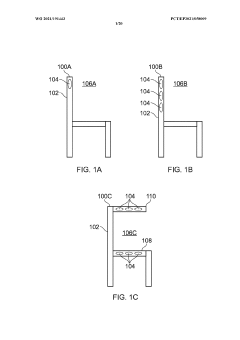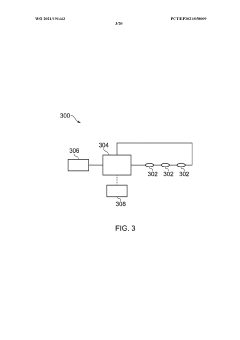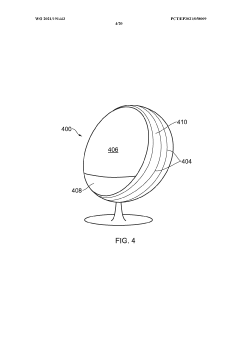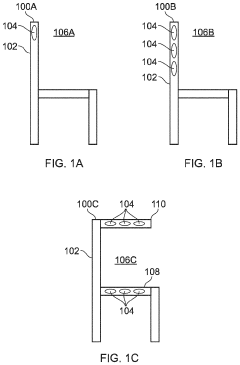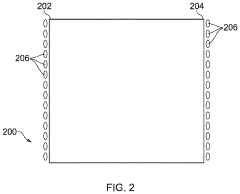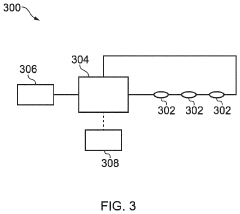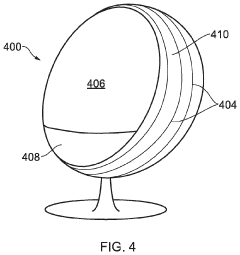Schumann Resonance Fluctuations: Causes and Effects
Schumann Resonance Background and Research Objectives
The Schumann resonance, discovered by physicist Winfried Otto Schumann in 1952, is a set of spectrum peaks in the extremely low frequency (ELF) portion of the Earth's electromagnetic field spectrum. These resonances occur between the Earth's surface and the ionosphere, creating a natural electromagnetic cavity. The fundamental frequency of this resonance is approximately 7.83 Hz, with harmonics at higher frequencies.
The study of Schumann resonance fluctuations has gained significant attention in recent years due to its potential implications for various fields, including atmospheric science, geophysics, and even human health. These fluctuations are believed to be influenced by a complex interplay of factors, including solar activity, geomagnetic storms, and changes in the Earth's ionosphere.
The primary objective of research into Schumann resonance fluctuations is to understand the underlying causes and effects of these variations. This includes investigating the relationship between Schumann resonance and global lightning activity, as well as exploring potential connections to climate change and other large-scale environmental phenomena.
One key area of focus is the impact of solar activity on Schumann resonance. Solar flares and coronal mass ejections can significantly alter the Earth's ionosphere, potentially leading to measurable changes in Schumann resonance frequencies and amplitudes. Researchers aim to develop more accurate models for predicting these fluctuations based on solar activity patterns.
Another important aspect of Schumann resonance research is its potential applications in monitoring global climate and weather patterns. Some studies suggest that variations in Schumann resonance may correlate with changes in global temperature, precipitation, and other climatic factors. Understanding these relationships could provide valuable insights into long-term climate trends and help improve climate prediction models.
The effects of Schumann resonance fluctuations on biological systems, particularly human health, have also become a subject of increasing interest. Some researchers hypothesize that these electromagnetic frequencies may influence circadian rhythms, melatonin production, and other physiological processes. While these claims remain controversial, they highlight the need for further investigation into the potential biological impacts of Schumann resonance variations.
As technology advances, researchers are developing more sensitive and accurate methods for measuring and analyzing Schumann resonance fluctuations. This includes the use of sophisticated ELF receivers, advanced signal processing techniques, and global networks of monitoring stations. These tools are enabling scientists to gather more comprehensive data on Schumann resonance variations and their potential correlations with various natural phenomena.
Market Applications of Schumann Resonance Monitoring
Schumann resonance monitoring has emerged as a promising technology with diverse market applications across various sectors. In the field of geophysics and earth sciences, Schumann resonance measurements provide valuable insights into global lightning activity, ionospheric conditions, and potential earthquake precursors. This data is crucial for improving weather forecasting models, studying climate change impacts, and developing early warning systems for natural disasters.
The telecommunications industry has shown increasing interest in Schumann resonance monitoring for its potential to enhance radio wave propagation predictions. By understanding the fluctuations in the Earth-ionosphere cavity, companies can optimize their communication systems, particularly for long-range and low-frequency transmissions. This application is especially relevant for improving global navigation satellite systems (GNSS) accuracy and reliability.
In the realm of renewable energy, Schumann resonance monitoring offers a novel approach to optimizing the performance of solar and wind farms. By correlating Schumann resonance data with atmospheric conditions, energy companies can better predict and manage power generation fluctuations, leading to more efficient grid integration of renewable sources.
The healthcare sector has begun exploring the potential therapeutic applications of Schumann resonance. Some researchers suggest that exposure to artificial Schumann resonance frequencies may have positive effects on human health, including stress reduction and improved sleep quality. This has led to the development of specialized medical devices and wellness products that simulate the Earth's natural electromagnetic environment.
Environmental monitoring agencies are incorporating Schumann resonance data into their comprehensive assessment of global environmental health. The resonance patterns serve as a unique indicator of the Earth's electromagnetic state, potentially reflecting changes in atmospheric composition, pollution levels, and overall planetary well-being.
In the aerospace industry, Schumann resonance monitoring is being investigated for its potential to improve spacecraft navigation and communication systems. Understanding the Earth's electromagnetic environment is crucial for developing more robust technologies for space exploration and satellite operations.
The growing interest in Schumann resonance applications has spurred the development of specialized monitoring equipment and data analysis software. This has created a niche market for high-precision electromagnetic sensors, signal processing tools, and data visualization platforms tailored to Schumann resonance research and applications.
As awareness of Schumann resonance grows, there is an emerging market for educational and scientific outreach products. Universities, research institutions, and science museums are incorporating Schumann resonance demonstrations and interactive exhibits into their programs, fostering public engagement with Earth sciences and electromagnetic phenomena.
Current Challenges in Schumann Resonance Detection
Despite significant advancements in Schumann resonance detection technologies, researchers still face several challenges in accurately measuring and interpreting these low-frequency electromagnetic waves. One of the primary obstacles is the low signal-to-noise ratio inherent in Schumann resonance measurements. The extremely weak nature of these signals, typically in the range of a few picoTeslas, makes them susceptible to interference from various natural and anthropogenic sources.
Environmental factors pose another significant challenge. Variations in local geology, atmospheric conditions, and solar activity can all influence Schumann resonance measurements. These factors can introduce noise and distortions into the data, making it difficult to isolate and analyze the true Schumann resonance signals. Additionally, the global nature of Schumann resonances requires a network of synchronized detection stations, which presents logistical and technical hurdles in maintaining consistent data quality across different geographical locations.
The complexity of Schumann resonance waveforms further complicates detection efforts. The resonances consist of multiple modes with varying frequencies and amplitudes, which can overlap and interact in complex ways. Separating these modes and accurately determining their individual characteristics demands sophisticated signal processing techniques and advanced mathematical models.
Another challenge lies in the long-term monitoring of Schumann resonances. Detecting subtle changes and trends over extended periods requires highly stable and sensitive equipment capable of maintaining consistent performance under varying environmental conditions. This need for long-term stability presents both technical and financial challenges in the design and maintenance of detection systems.
The interpretation of Schumann resonance data also remains a significant challenge. While correlations between Schumann resonance fluctuations and various geophysical and atmospheric phenomena have been observed, establishing clear causal relationships is often difficult. This complexity is compounded by the global nature of the resonances, which integrate information from various sources worldwide, making it challenging to attribute observed changes to specific events or processes.
Lastly, the interdisciplinary nature of Schumann resonance research presents its own set of challenges. Effective study in this field requires collaboration between experts in atmospheric physics, electromagnetics, signal processing, and geophysics, among others. Bridging these diverse areas of expertise and integrating different methodologies and perspectives can be challenging but is crucial for advancing our understanding of Schumann resonances and their potential applications.
Existing Methods for Measuring Schumann Resonances
01 Measurement and analysis of Schumann resonance fluctuations
Various devices and methods are developed to measure and analyze Schumann resonance fluctuations. These systems often include sensors, signal processing units, and data analysis tools to detect and interpret changes in the Earth's electromagnetic field. The analysis of these fluctuations can provide insights into global weather patterns, ionospheric conditions, and other geophysical phenomena.- Measurement and analysis of Schumann resonance fluctuations: Various devices and methods are developed to measure and analyze Schumann resonance fluctuations. These systems often include sensors, signal processing units, and data analysis tools to detect and interpret changes in the Earth's electromagnetic field. The analysis of these fluctuations can provide insights into global weather patterns, ionospheric conditions, and other geophysical phenomena.
- Applications in health and wellness: Schumann resonance fluctuations are being explored for potential health and wellness applications. Devices and methods are developed to generate or simulate these frequencies, with the aim of promoting relaxation, improving sleep quality, or enhancing overall well-being. These applications often involve wearable devices or environmental systems that emit or modulate electromagnetic fields at specific frequencies.
- Integration with electronic devices and communication systems: Schumann resonance fluctuations are being considered in the design and operation of electronic devices and communication systems. This includes developing methods to mitigate potential interference from these natural electromagnetic phenomena or utilizing them to enhance signal propagation. Some applications focus on improving the reliability and efficiency of wireless communication systems in various environments.
- Environmental monitoring and prediction: Systems and methods are being developed to use Schumann resonance fluctuations for environmental monitoring and prediction. These applications include tracking changes in global temperature, monitoring seismic activity, or predicting severe weather events. The analysis of these fluctuations can provide valuable data for climate research and early warning systems for natural disasters.
- Energy harvesting and power generation: Research is being conducted on the potential use of Schumann resonance fluctuations for energy harvesting and power generation. This includes developing novel antenna designs and energy conversion systems that can capture and utilize the electromagnetic energy present in these natural resonances. While still largely experimental, this field explores the possibility of creating sustainable energy sources based on Earth's electromagnetic phenomena.
02 Applications in health and wellness
Schumann resonance fluctuations are being explored for potential health and wellness applications. Devices and methods are developed to generate or simulate these frequencies, with the aim of promoting relaxation, improving sleep quality, or enhancing overall well-being. These applications often involve wearable devices or environmental systems that emit electromagnetic fields at specific frequencies.Expand Specific Solutions03 Integration with electronic devices and communication systems
Schumann resonance fluctuations are being considered in the design and operation of electronic devices and communication systems. This includes developing methods to mitigate potential interference from these natural electromagnetic phenomena or utilizing them to enhance signal propagation. Some applications focus on improving the reliability and efficiency of wireless communication systems.Expand Specific Solutions04 Environmental monitoring and climate research
Schumann resonance fluctuations are utilized in environmental monitoring and climate research. Systems are developed to track these fluctuations as indicators of global climate changes, atmospheric conditions, or seismic activities. This research aims to improve our understanding of Earth's complex environmental systems and potentially contribute to early warning systems for natural disasters.Expand Specific Solutions05 Energy harvesting and power generation
Innovative approaches are being explored to harness Schumann resonance fluctuations for energy harvesting and power generation. These methods aim to convert the natural electromagnetic energy into usable electrical power, potentially providing a novel renewable energy source. While still in early stages, this research could lead to new ways of generating clean energy on a global scale.Expand Specific Solutions
Key Players in Schumann Resonance Studies
The research on Schumann Resonance Fluctuations is in an exploratory phase, with a growing market driven by increasing interest in Earth's electromagnetic field and its potential effects on human health and technology. The market size is relatively small but expanding, attracting diverse players from academia and industry. Technologically, it's still in early stages of maturity, with companies like Murata Manufacturing Co. Ltd. and Siemens Healthcare GmbH potentially applying their expertise in electromagnetic sensors and medical devices. Universities such as Southeast University and the University of Bern are likely leading fundamental research, while corporations like FUJIFILM Corp. and Koninklijke Philips NV may be exploring applications in imaging and healthcare. The field presents opportunities for interdisciplinary collaboration and innovative applications across multiple sectors.
Southeast University
University of Bern
Innovative Approaches in Schumann Resonance Analysis
- A magnetic field exposure system generating an amplitude-modulated low frequency magnetic field with a carrier frequency of 360 to 450 Hz and a modulation frequency of 0.5 to 100 Hz, with a field strength of 0.5 to 250 mT, specifically designed to expose organic cells or tissues to improve cell survival, proliferation, reduce stress, and enhance well-being.
- A magnetic field exposure system generating an amplitude-modulated low frequency magnetic field with a carrier frequency of 360 to 450 Hz and a modulation frequency of 0.5 to 100 Hz, providing a field strength of 0.5 to 250 μT, specifically designed to enhance cell survival, proliferation, reduce stress, and promote tissue regeneration.
Environmental Factors Affecting Schumann Resonances
Schumann resonances, the global electromagnetic resonances occurring in the Earth-ionosphere cavity, are influenced by various environmental factors. These factors play a crucial role in modulating the resonance frequencies and amplitudes, contributing to the observed fluctuations in Schumann resonance measurements.
One of the primary environmental factors affecting Schumann resonances is global lightning activity. As the main excitation source for these resonances, changes in lightning distribution and intensity directly impact the resonance characteristics. Seasonal variations in thunderstorm activity, particularly in tropical regions, lead to noticeable shifts in Schumann resonance parameters.
Solar activity also plays a significant role in modulating Schumann resonances. Solar flares and coronal mass ejections can cause disturbances in the ionosphere, altering its conductivity and height. These changes affect the propagation of electromagnetic waves within the Earth-ionosphere cavity, resulting in variations in Schumann resonance frequencies and amplitudes.
Atmospheric conditions, such as temperature, humidity, and pressure, influence the propagation of electromagnetic waves in the lower atmosphere. These factors can affect the coupling between the Earth's surface and the ionosphere, thereby impacting Schumann resonance measurements. For instance, changes in the vertical temperature profile of the atmosphere can modify the reflection and transmission properties of electromagnetic waves.
Geomagnetic activity is another crucial environmental factor affecting Schumann resonances. Geomagnetic storms, caused by interactions between the Earth's magnetosphere and the solar wind, can lead to significant perturbations in the ionosphere. These disturbances can alter the conductivity profile of the Earth-ionosphere cavity, resulting in observable changes in Schumann resonance parameters.
Anthropogenic activities also contribute to environmental factors influencing Schumann resonances. Electromagnetic noise generated by human-made sources, such as power lines, radio transmissions, and industrial activities, can interfere with Schumann resonance measurements. This anthropogenic noise can mask or distort the natural resonance signals, particularly in urban or industrialized areas.
Climate change and its associated effects on global weather patterns may have long-term impacts on Schumann resonances. Changes in global temperature, precipitation patterns, and extreme weather events could alter the distribution and intensity of lightning activity, potentially leading to shifts in Schumann resonance characteristics over time.
Understanding these environmental factors and their complex interactions is crucial for accurately interpreting Schumann resonance data and utilizing it for various applications, such as global lightning monitoring, ionospheric studies, and potentially as an indicator of global climate change.
Potential Health Implications of Schumann Resonance Fluctuations
The potential health implications of Schumann resonance fluctuations have garnered increasing attention in recent years. These extremely low frequency electromagnetic waves, resonating between the Earth's surface and the ionosphere, have been hypothesized to influence various aspects of human health and well-being.
One of the primary areas of interest is the potential impact on circadian rhythms and sleep patterns. Some researchers suggest that variations in Schumann resonances may affect the production of melatonin, a hormone crucial for regulating sleep-wake cycles. Studies have indicated that exposure to electromagnetic fields similar to Schumann resonances can alter melatonin levels in humans, potentially leading to sleep disturbances and related health issues.
Cardiovascular health is another area where Schumann resonance fluctuations may play a role. Preliminary research has shown correlations between changes in these resonances and variations in heart rate variability, blood pressure, and other cardiovascular parameters. While the exact mechanisms are not fully understood, it is hypothesized that these electromagnetic waves may influence the autonomic nervous system, which regulates many bodily functions.
The potential impact on cognitive function and mental health has also been a subject of investigation. Some studies suggest that Schumann resonance fluctuations may affect brain wave patterns, potentially influencing mood, attention, and cognitive performance. However, the evidence in this area remains largely inconclusive and requires further research to establish clear causal relationships.
Immune system function is another aspect of health that may be influenced by Schumann resonance fluctuations. Preliminary studies have indicated potential effects on various immune markers and cellular processes. However, the complexity of the immune system and the multitude of factors influencing it make it challenging to isolate the specific impact of these electromagnetic waves.
It is important to note that while these potential health implications are intriguing, much of the research in this field is still in its early stages. Many studies have been small-scale or observational, and larger, more rigorous clinical trials are needed to establish definitive links between Schumann resonance fluctuations and specific health outcomes.
Furthermore, the effects of these resonances may vary significantly between individuals, depending on factors such as genetic predisposition, overall health status, and environmental conditions. This variability adds another layer of complexity to understanding the potential health implications and developing targeted interventions or preventive measures.
